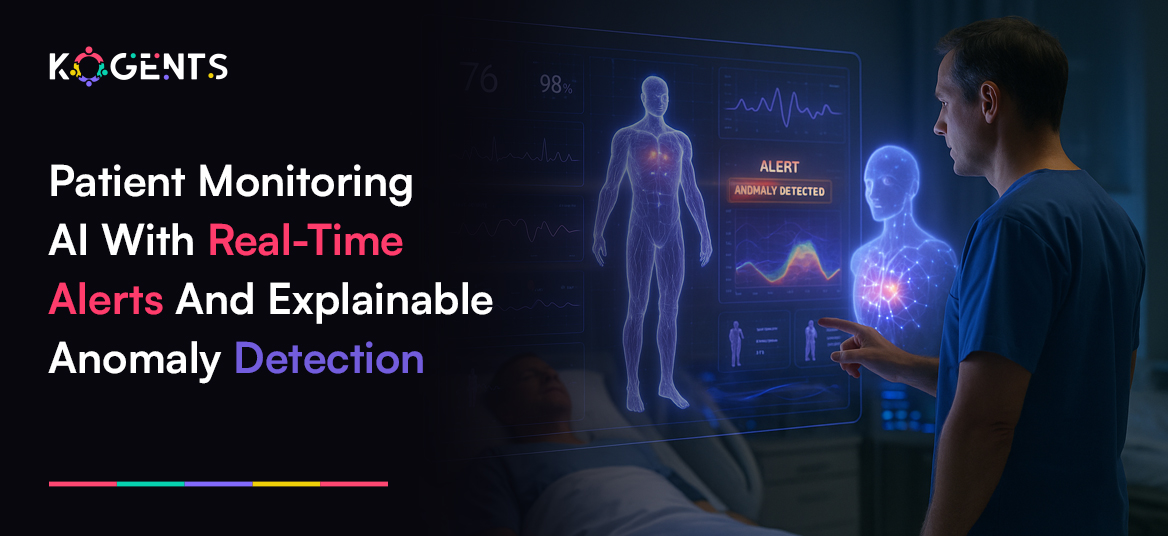Patient monitoring AI with real-time alerts and explainable anomaly detection

Summary:
You must be aware of the fact that hospitals generate massive streams of physiological data, including heart rate, SpO₂, respiratory rate, blood pressure, and ECG waveforms, 24 hours a day.
Yet clinicians can process only a fraction of this flood in real time. The result: alert fatigue, delayed interventions, and preventable harm.
Enter Patient Monitoring AI, an intelligent layer that continuously interprets vital-sign data, detects early anomalies, and triggers timely alerts.
By combining machine learning, sensor fusion, and explainable algorithms, AI-based monitoring systems promise to reduce clinical risk while restoring clinicians’ trust in automation.
This article explores how patient monitoring AI enables real-time alerts and explainable anomaly detection, the technologies driving it, and why transparency is the key to widespread adoption.
Key Takeaways
- How AI-driven patient monitoring improves real-time clinical decisions and patient safety.
- Why explainable AI (XAI) builds trust through transparent alerts.
- How edge-to-cloud analytics enable continuous, context-aware monitoring.
- How AI patient scheduling boosts hospital efficiency and staff coordination.
- The future of predictive, proactive healthcare powered by intelligent automation.
What Is Patient Monitoring AI?
It refers to artificial intelligence systems that analyze physiological signals and clinical parameters to detect anomalies, predict patient deterioration, and generate real-time alerts.
Unlike traditional systems that rely on static thresholds (“alert if HR > 120”), AI-driven platforms learn normal ranges per individual and continuously update their understanding of patient baselines.
Core Components
- Data ingestion layer: integrates continuous feeds from bedside monitors, wearables, or IoMT (Internet of Medical Things) sensors.
- Machine learning engine: applies models such as LSTM networks, CNNs, and Random Forests to detect trends or sudden deviations.
- Explainability interface (XAI): provides human-readable reasoning behind alerts.
- Integration API: connects with EHR systems, nurse dashboards, and mobile alerts.
This approach allows hospitals to move from reactive to predictive care, addressing complications before they escalate.

Why Real-Time Monitoring Matters?
In critical care, time is measured in heartbeats. A delay of 60 seconds can mean cardiac arrest or irreversible hypoxia.
Real-time patient monitoring enables clinicians to act within that “golden minute.”
Traditional monitors often trigger hundreds of false alarms per shift—up to 80–90% in ICUs—causing desensitization and slower response times.
AI mitigates this by filtering noise and recognizing contextual anomalies rather than isolated spikes.
Key Benefits
- Early warning detection: Predict sepsis or acute respiratory failure hours in advance.
- Reduced alert fatigue: Adaptive thresholds cut false positives.
- Remote visibility: Tele-ICUs and home-care platforms monitor patients continuously.
- Operational efficiency: AI triages, which alert to require immediate attention, while AI patient scheduling algorithms synchronize clinician availability with urgent cases, minimizing response delays.
The Role of AI in Continuous Monitoring
AI transforms patient monitoring into a dynamic decision-support system. It doesn’t just collect numbers; it interprets them in context.
Data Fusion and Predictive Analytics
Modern monitoring systems combine multiple input streams, vital signs, lab results, imaging, and clinician notes, using sensor fusion and multimodal deep learning.
Algorithms detect latent correlations: a subtle change in respiratory rate, when combined with a shift in ECG variability, might predict deterioration hours before traditional metrics show it.
Machine Learning Techniques
| Model Type | Example Use | Benefit |
| LSTM / RNN | Time-series forecasting of heart rate trends | Captures temporal dependencies |
| CNN | ECG waveform classification | Detects subtle morphological changes |
| XGBoost / Random Forest | Feature-based anomaly scoring | Fast, interpretable, and lightweight |
| Autoencoders | Unsupervised anomaly detection | Identifies unseen patterns without labeled data |
These models form the computational backbone of AI-assisted patient monitoring, scanning thousands of data points per second and prioritizing clinically meaningful signals.
Real-Time Alerts: How They Work
Real-time alerting is the operational core of any patient monitoring AI platform. Here’s how a typical alert pipeline functions:
- Data acquisition: Continuous signals (ECG, SpO₂, BP) are streamed via IoMT sensors.
- Preprocessing: Noise reduction, signal normalization, and missing-data handling.
- Inference: The AI model calculates risk scores or anomaly likelihoods.
- Decision logic: If the score exceeds an adaptive threshold, an alert is generated.
- Notification: The system routes the alert to nurse stations, mobile apps, or EHR dashboards, often prioritized by severity.
Unlike conventional systems that react to absolute values, AI considers the rate of change, cross-signal relationships, and patient history.
The result: earlier, smarter alerts, fewer false alarms, and more actionable insights.
Explainable Anomaly Detection: Making AI Trustworthy
For AI to be trusted in healthcare, it must be explainable.
Clinicians must understand why an alert was triggered, not just that it was.
What Is Explainable AI (XAI)?
It provides interpretability layers that make algorithmic outputs transparent. Techniques such as
- SHAP (Shapley Additive exPlanations),
- LIME (Local Interpretable Model-agnostic Explanations)
- Attention visualization
All reveal which features contributed most to an anomaly score.
Example:
A notable example in the AI doctor diagnosis system that seems to detect hypoxia might explain:
“Alert generated because SpO₂ dropped 4% below personal baseline and correlated with a 15% rise in respiratory rate over 10 minutes.”
Such clarity builds clinical confidence and supports regulatory compliance (FDA, CE Mark) by making decisions auditable.
Comparison: Traditional vs. AI-Based Patient Monitoring
| Feature | Traditional Monitoring | AI-Powered Patient Monitoring |
| Data Processing | Manual, reactive | Automated, predictive |
| Alert Mechanism | Fixed thresholds | Context-aware adaptive alerts |
| Scalability | Limited to bedside | Scales across wards and remote settings |
| Accuracy | High false positives | Learns from feedback to improve |
| Explainability | Basic (rule-based) | Advanced via XAI tools |
| Integration | Device-specific | Unified via EHR / cloud APIs |
| Care Model | Reactive | Preventive and proactive |
Use Cases and Real-World Applications
1. ICU Early Warning Systems
- Hospitals like Mount Sinai are deploying AI models that detect sepsis or cardiac deterioration hours earlier than clinical judgment.
- Systems analyze heart rate variability, blood pressure, and temperature to trigger predictive alerts, allowing clinicians to intervene proactively.
2. Post-Surgical Monitoring
- AI monitors track wound infection risk and detect abnormal pain responses using biosensors.
- Some integrate computer vision to interpret facial expressions and movement, combining visual data with vitals for multimodal inference.
3. Remote Patient Monitoring (RPM)
- Platforms such as Empatica leverage wearable sensors and edge computing to analyze vitals in real time, ideal for chronic disease management and telehealth.
- For instance, diabetic patients’ glucose and heart rate data are analyzed continuously, generating alerts directly to physicians through cloud dashboards.
4. Elderly and Fall Detection
AI-enabled ambient sensors detect motion anomalies, such as gait instability or inactivity, triggering caregiver alerts without the need for intrusive cameras.
Business Impact: ROI, Efficiency, and Scalability
For healthcare executives, the economic case for AI agents for healthcare automation and monitoring is compelling.
1. Reduced ICU Stays and Readmissions
Predictive monitoring decreases unplanned transfers and accelerates recovery, cutting average ICU stays by 10–15% in pilot studies.
2. Lower Operational Costs
Automation enables nurse-to-patient ratios to scale efficiently.
A single AI system can supervise hundreds of patients remotely, augmenting staff rather than replacing them.
3. Regulatory and Quality Compliance
Explainability features help meet FDA, HIPAA, and ISO 13485 requirements, ensuring algorithmic decisions are traceable and privacy-compliant.
4. Competitive Differentiation
Hospitals adopting AI-assisted patient monitoring can market themselves as smart hospitals, improving brand perception, attracting top talent, and fostering innovation partnerships with MedTech startups.
Technical Architecture Overview
A robust AI-based patient monitoring system typically includes the following layers:
- Edge Layer: IoMT sensors and wearable devices capture biosignals. Edge inference ensures latency-free alerting.
- Communication Layer: Encrypted data channels (MQTT, HL7 FHIR APIs) transmit signals to cloud or on-prem servers.
- Analytics Layer: ML models (LSTM, Autoencoders) perform anomaly scoring and risk prediction.
- Explainability Layer: XAI frameworks generate human-readable visualizations.
- Application Layer: Dashboards, clinician apps, and EHR integrations display real-time insights.
Highlight: This modular design allows flexibility, cloud scalability for large hospitals, and edge computing for local clinics with bandwidth constraints.
Learn Ethical, Privacy, and Regulatory Challenges
While the promise of patient monitoring AI is immense, so are its challenges.
1. Data Privacy and Security
- Systems must comply with HIPAA (US) and GDPR (EU).
- Techniques like federated learning and differential privacy allow AI models to learn from distributed data without exposing sensitive information.
2. Model Drift and Continuous Validation
Physiological data patterns can change over time; ongoing model monitoring is essential to maintain performance and fairness.
3. Bias and Interpretability
- Models trained on homogeneous datasets risk underperforming across diverse populations.
- Transparent explainability mitigates this by exposing bias patterns early.
4. Human Oversight
- AI should complement, not replace, clinical judgment.
- Establishing human-in-the-loop frameworks ensures accountability and maintains trust.

The Future of Patient Monitoring AI
The next generation of patient monitoring AI will be:
- Edge-native: Running on local devices for instant response.
- Context-aware: Combining behavioral, environmental, and physiological data.
- Personalized: Adapting to each patient’s baseline and genomic profile.
- Federated and secure: Learning across institutions without centralizing data.
- Regulation-ready: Built for explainability and ethical transparency.
As hospitals evolve into smart, connected ecosystems, patient monitoring AI will become the nerve center of proactive healthcare, integrating with clinical decision support, workflow automation, and even robotic nursing assistants.
Redefine The Future of Digital Healthcare With Kogents Today!
Patient Monitoring AI represents a paradigm shift from reactive treatment to proactive prevention.
Through real-time alerts, anomaly detection, and explainable intelligence, AI empowers clinicians to act sooner, with greater confidence and context.
The convergence of IoMT sensors, predictive analytics, and explainable AI isn’t just transforming patient monitoring; it’s redefining the future of digital healthcare.
So, give Kogents.ai this chance to further assist you. Give us a call at +1 (267) 248-9454 or email us at info@kogents.ai.
FAQs
What is patient monitoring AI?
AI systems that continuously analyze patient vitals to detect anomalies and trigger real-time alerts for clinicians.
How does AI improve patient monitoring accuracy?
By learning patient-specific baselines, reducing false positives, and identifying complex patterns beyond static thresholds.
What technologies power patient monitoring AI?
Machine learning models (LSTM, CNN), IoMT sensors, edge computing, and explainable AI frameworks like SHAP or LIME.
Why is explainable anomaly detection important?
It ensures clinicians understand why an alert was triggered, promoting transparency and regulatory trust.
Can AI replace nurses or doctors in monitoring?
No, AI augments human judgment, automating repetitive surveillance so clinicians focus on care.
How does patient monitoring AI reduce alert fatigue?
Adaptive learning minimizes unnecessary alerts by distinguishing real anomalies from normal variability.
Is patient data secure in AI systems?
Yes, using encryption, HIPAA compliance, and privacy-preserving techniques like federated learning.
What are some real-world examples?
Care.ai, Empatica, and Philips IntelliVue use AI for ICU and remote patient monitoring.
What’s the ROI for hospitals implementing patient monitoring AI?
Improved outcomes, shorter ICU stays, reduced readmissions, and optimized staffing efficiency.
What’s next for this technology?
Edge AI, personalized analytics, and integration with broader digital health ecosystems like smart hospital rooms.

Kogents AI builds intelligent agents for healthcare, education, and enterprises, delivering secure, scalable solutions that streamline workflows and boost efficiency.